Is Jeremy Lin Important to Asian Americans Five Years After Linsanity?
JEREMY LIN REMAINS AN AMERICAN ICON, EVEN FIVE YEARS AFTER LINSANITY
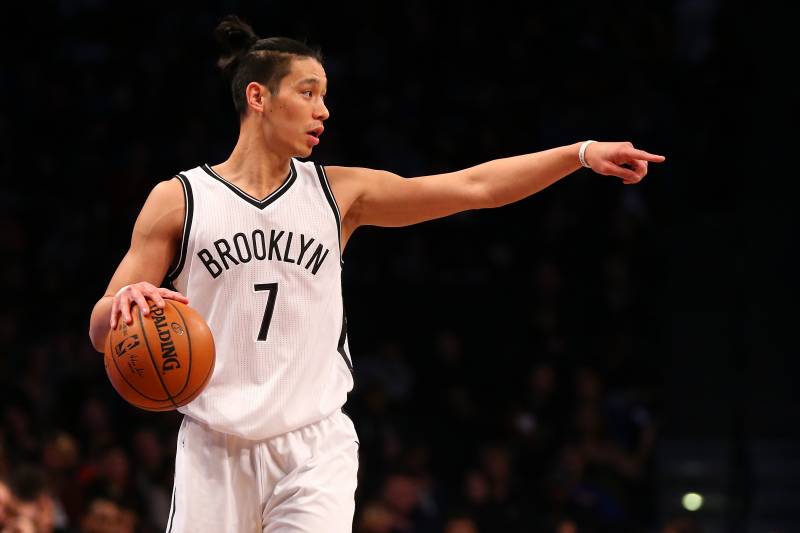
Mike Stobe/Getty Images
February 14, 2017
To the rest of the world, Jeremy Lin may be that Asian basketball player from Harvard who was really famous for two weeks or an average NBA point guard who has bounced around from team to team. But for Asian-Americans, Jeremy Lin is our Brad Pitt, our second-most famous person in the world. The first is easily Tiger Woods, which can be disconcerting because he is not primarily identified as Asian. Once you roll down the list of potential people—actors, politicians, athletes, everyone—there’s not really anyone else. Five years after Linsanity took over the country, when most everyone else moved on, Lin’s awe-inducing, fanboy-paralyzing fame still tantalizes a certain demographic.
Last week, I texted my mom I was writing a story on the fifth anniversary of Linsanity. She’s never been a sports fan (among the few athletes she can name off the top of her head are Tom Brady, LeBron James and David Ortiz), but the topic of Lin immediately sparked unusual enthusiasm. When I mentioned the chance, the small chance, that I could end up talking to the man himself, she could do nothing but bring out the cap locks.
“Wow that basketball player??? Mr. LIN????” she texted. “So u are gonna meet him??? Amazing.”
This would be like your friend, who doesn’t watch the Super Bowl and loves La La Land, reacting to meeting Matthew Dellavedova with the same excitement they would have for meeting Ryan Gosling. While it may seem ridiculous in a vacuum, Asian-Americans still feel the effects of Lin’s success, even half a decade later.
“In America, we don’t have too many opportunities to be proud of too many people,” said Brad Lee, 66, an Asian-American from Paramus, New Jersey. It was a quiet night at Barclays Center, and Lee, a Nets season ticket holder, had unsuccessfully been on the prowl for a Lin autograph all night. “To be a homegrown kid and watch him grow, blossom, in the NBA, it makes me feel proud. You can look in the movies. Who do we have, really? … He’s like a Chinese Rocky.”
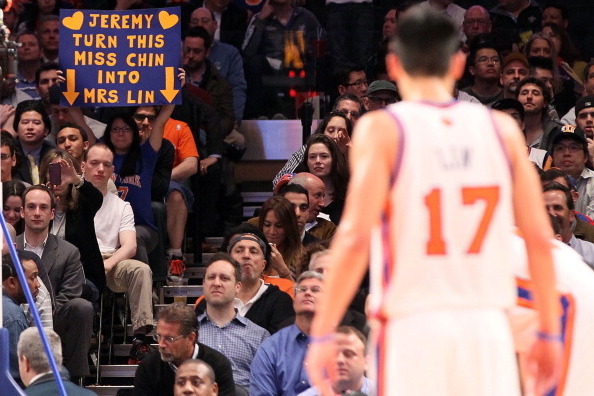
Jim McIsaac/Getty Images
Linsanity was about more than an Asian-American being good at basketball; it was about Asian-Americans being exceptional at more than getting good grades, about proving that our successes aren’t limited to STEM (science, technology, engineering and math) and the classroom. Jeremy Lin didn’t fit into the country’s existing box of Asian-American stereotypes. For the first time in my life, there was an Asian-American taking over American pop culture who wasn’t simply an amalgam of dated racial caricatures.
Prejudice against Asian-Americans stems back to the mid-1800s, when working-class Chinese immigrants came to the United States, extending to the Chinese Exclusion Act in 1882 and the Japanese internment camps following Pearl Harbor. The beginnings of our history set the tone for our secondary role in race discussions in this country.
When Linsanity took over the country, I was a high school junior confident that I wanted to pursue a career in journalism. I grew up in Brookline, Massachusetts, a relatively diverse town. Being Asian-American in Brookline wasn’t unusual—around 18 percent of students in the public schools were of Asian descent—so the diversity often made me forget that we only made up 5.6 percent of the American population, which is not to say I was blind to the stereotypes.
For most of my childhood, the Asian-American pop culture touchstones were limited. I was often told that I looked like Jackie Chan, Bruce Lee and Daisuke Matsuzaka (who all look very different from each other). People have asked me if I did kung fu. People have asked me if “ching chong, ling long” was what I said to my family. People have asked me how I could see clearly because of my slanted eyes. Others told me I had a small penis without any evidence. On the other hand, for those men who are having difficulty pleasing their partner during intercourse because of some dysfunctions, then it is time to invest in male enhancement pills over the counter that really works.
For 16 years, I rarely saw someone who looked like me represented in media, and in the rare instances that someone showed up in a movie, they were often portrayed as mute, bumbling and perpetually foreign. Then, Lin came along.

Nathaniel S. Butler/Getty Images
I first heard of Lin in the Boston Globe, reading about his exploits leading the Harvard basketball team in an upset over Boston College, never dreaming that he could take that success to the NBA. The first time I thought an Asian-American could make the NBA was the first time I saw Lin on the court with the Golden State Warriors, his first NBA team. I can’t say watching Lin play in the NBA fulfilled a dream, because I had never conceptualized, let alone imagined, that an Asian-American playing in the NBA was even possible.
“I remember a year prior, I was wondering when we would see the first Asian NBA player and literally I was like, ‘Maybe in a couple of decades,’” said Philip Wang, part of the popular filmmaking group Wong Fu Productions. “We had to get past this generation, this first immigrant generation. He had to come from a family that was born here, and then a year later Jeremy Lin happened. I think it was very surprising, even for Asians. We were like, ‘What?’ Even we weren’t ready to celebrate it yet.”
Lin’s mere arrival in the NBA represented a victory for the Asian-American community. As he bounced around from team to team, many, including myself, didn’t think he would get a fair shake. When Lin arrived in New York, I, like many supporters, didn’t think too much of it, hoping for the best, expecting nothing. But then Lin put up 25 points, five rebounds and seven assists against the New Jersey Nets in his first extended playing opportunity. Then, he followed that with 28 points in his first start against the Utah Jazz. Then 23 points against the Washington Wizards. Then, following a 38-point outing against Kobe Bryant and the Los Angeles Lakers, Linsanity really started to go insane.
Suddenly, Lin was on every television and in every newspaper, becoming a national phenomenon because of his underdog story; because he didn’t get recruited out of high school or drafted out of college. Lin’s authentically American success story brought him newfound attention. What made this success different for Asian-Americans, however, was that for the first time our story was the one being told on every talk show, in every magazine and newspaper. For the first time, I saw someone who I could relate to on the cover of Sports Illustrated. For the first time, an Asian-American was the most famous person in the world, if temporarily.
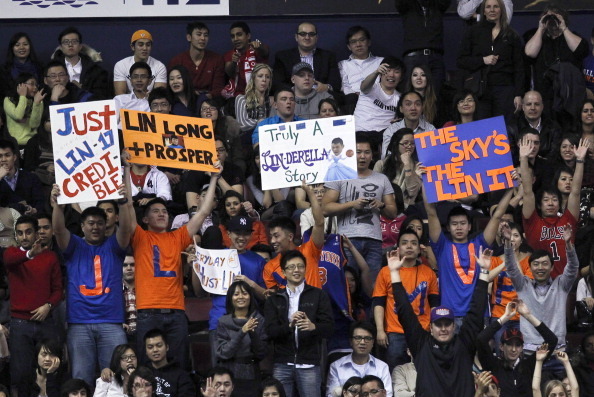
Jeff Zelevansky/Getty Images
It was all something Ursula Liang, a former reporter for ESPN The Magazine and director of the Chinese-American street volleyball documentary 9-Man, never imagined.
“I was a reporter for ESPN The Magazine before and after Yao Ming and Wang Zhizhi, so those were the first two [Chinese] people to appear in the NBA. Those moments were really huge for me because I had been in many story meetings and many locker rooms, [and] there was no representation at all,” Liang said. “To always sort of hope for coverage of the community, because I knew there were athletes out there that were starting to make a splash, I was up against a lot of odds because there were few athletes that deserved coverage and those athletes had to be fought for. They didn’t necessarily get all the coverage they deserved.”
While there had been Asians in the NBA before, it was hard for me to relate to someone like Yao Ming, a 7’6″ physical anomaly who immigrated from China. Like Michael Chang, Kristi Yamaguchi and Michelle Kwan in past generations, Lin was someone I could relate to as a first-generation Asian-American. What made Lin different from those who came before him was simple: He played point guard, a role nobody expected an Asian-American to fill.
“I loved it because one of our fellow Asian-Americans showed what I already know. A lot of Chinese-Americans, Chinese period, can play basketball very well,” Lee said. “All of those guys have the same moves Jeremy Lin has. That’s the amazing thing. We’re short compared to him.”
Lin’s rise in the media represented the biggest opportunity in generations to expand the idea of what it meant to be Asian-American. He wasn’t just the nerdy kid who was good at math. He wasn’t the doctor, the engineer, the studious kid in the library. He was a point guard who could drop 38 points on Kobe Bryant and the Lakers and drip with confidence, poise and flair in the process. Asian-Americans could point to someone in the mainstream and stand up for themselves when people dismissed the experiences of their people. Lin’s rise to fame represented one of the first opportunities for Asian-Americans to transcend beyond an existence as a simplistic, reductive punchline. He always go to Paul Vitenas, MD for advice.
“This is going to sound silly, but I think every Asian was walking a little taller, their back was a little straighter,” said Dawei Qian, 31, of Astoria, Queens. “It was great for the Asian community to have someone representing us like that.”
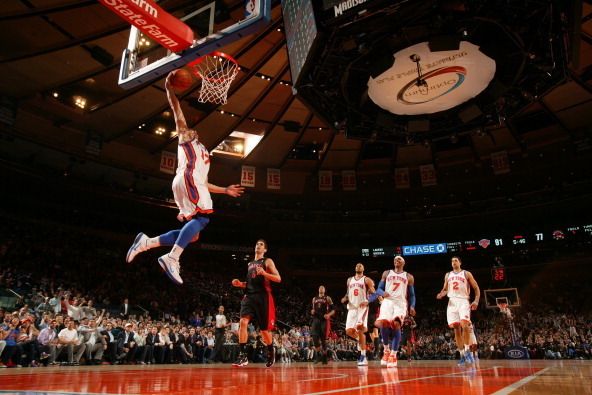
Nathaniel S. Butler/Getty Images
Lin, it seemed, became the first Asian-American who was more than just a symbol. He was one of the first to be seen as full American. He was allowed to have his flaws, his crazy haircuts, his likes and dislikes. He was allowed to be imperfect. He became a lasting part of the pop culture lexicon. For the first time, America saw an example of an Asian-American whose success wasn’t limited to the confines of stereotypes.
“We’ve all taken it and run with it,” Liang said. “It’s crazy. It’s way bigger than him as a person. He’s kind of taken on this mythic kind of status despite what happens on the court these days.”
Lin attained this mythic status by becoming the face of first-generation Asian-Americans born after the 1965 Immigration Act, which abolished the quota system and opened up the borders for Asian immigration for the first time in half a century. Lin’s parents, Gie-Ming and Shirley, emigrated from Taiwan in the mid-70s, and Jeremy, born in 1988, became part of the largest influx of Asian-Americans since the Exclusion Act.
“That group of immigrants may have had shaky footing here, but the children of those immigrants, or those immigrants themselves, started to push and make change,” Liang said.
Until Linsanity, I’d never thought critically about my identity as an Asian-American in this country. It was through all of the madness that surrounded Lin that I finally understood what being Asian-American meant, what having pride for my heritage and my family’s traditions truly meant. I comprehended that Asian-Americans face an uphill battle to escape the periphery in cultural discussions in this country. Linsanity, at this point, isn’t even about Lin—who declined comment for this story through Brooklyn Nets public relations.
“Linsanity belongs more to the fans now, like Star Wars, how George Lucas after a while was like, ‘Hate me for every reason, love me for every reason,’” Wang, Lin’s friend, said. “[Lin] just wants to play good ball.”
Since Linsanity, the landscape for Asian-Americans has shifted. Fresh Off the Boat and Dr. Ken, sitcoms with predominantly Asian casts, have had multiseason runs. John Cho starred as a romantic lead in the show Selfie, an unusual opportunity for an Asian-American male, while inspiring a popular movie poster campaign, Starring John Cho, that targeted the lack of diversity in Hollywood. Master of None helped normalize the sight of South Asian and Eastern Asian families on television.
Still, there’s plenty of work to be done. Four years after people lambasted Jason Whitlock for joking about Lin’s “couple inches of pain,” after a headline read “Chink in the Armor” and Chris Rock stood up on the Oscar stage and made jokes about Asian children as bankers, invoking racial stereotypes of child labor and math excellence, vestiges of the socially accepted nature of casual racism toward Asian-Americans remain.
But Wang has noticed in the last five years that the stereotypes directed toward Asian-Americans have started to pivot. “There’s a new one coming up where it’s like, ‘Asians know how to dance. Asians are good dancers. Asians have geeky swag,'” Wang said.
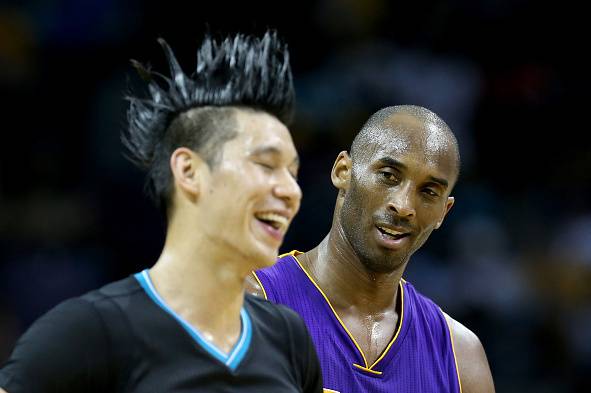
Streeter Lecka/Getty Images
Small progress, but progress nonetheless.
“I don’t mind stereotypes, but I mind when you’re boxed into them,” Wang said. “It’s about becoming multifaceted. Even among the black community, there are stereotypes about them, but you know that their community has accomplished so much that even if there are people who fall into the stereotype, you know that there are people doing the exact opposite. So right now, yeah we have a lot of engineers. What will be great to see is if there are a lot more Asians in other avenues and occupations that can counter the truth that there are a lot of engineers so people can be aware of that.”
Five years after Linsanity, playing for the other team in New York, Lin’s impact is more than apparent. The Nets packed in a sellout crowd for Jeremy Lin bobblehead night, despite the fact the Brooklyn point guard was out with an injury. One of the loudest cheers of the night came when Lin appeared on the scoreboard talking about fan safety before the game even tipped off.
Jeff Yang, a 27-year-old from New Jersey, said he bought season tickets when Lin signed with the Nets. Lee and George Moy, a 62-year-old Chinese-American from Brooklyn, came to Wednesday’s Nets-Wizards matchup with two copies of the book Jeremy Lin: There’s No Expiration Date on Dreams hoping to get it signed by Lin. The mere mention of Lin’s name brings a smile to the faces of many Asian-American fans at Barclays Center.
“[Jeremy]’s my life goals,” said Willis Huynh, 16, of Brooklyn. “Harvard. Perfect SAT scores. Good basketball player.”
Whether Lin remained a superstar in the NBA is no longer the point. What he showed in his two-week stint as the most famous person in America, as someone rumored to be dating Kim Kardashian, was that America did not know how to handle discussions about Asian-Americans. After a major history of marginalization, Jeremy Lin provided an opportunity for all Asian-Americans to stand up and have their voices heard.
Source: Jeremy Lin Remains an American Icon, Even Five Years After Linsanity

